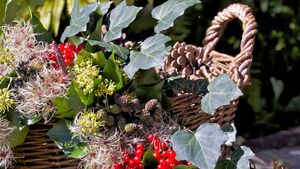Green Fingers: The long and the short of it all

Natural decorations are easy to make and look great.
Time does not stand still for anyone and the year has rolled on, which makes it hard to accept that this Friday it is December 20 and the ‘Winter Solstice’ or hibernal solstice on Saturday. In practical terms it is something to celebrate, as it is the shortest day or if you wish the longest night, after which the days start to become longer.
The Winter Solstice is one of the oldest winter celebrations dating from pagan times but nowadays it largely passes by unnoticed as it is under the shadow of the juggernaut that is the Christmas season.
The Winter Solstice varies between the 20th and the 23rd but it is a calculated date and occurs on a specific day and time. Newgrange, which can be traced back over 6,000 years, and its ancient passage illuminates by sunlight all the way into the inner chamber on the Winter Solstice - if it is not foggy.
Whatever about our ancestors living in a time of plenty during the summer months, it must have been difficult and tough to survive the winters and therefore the Winter Solstice was an opportunity to celebrate the coming of longer days and new life to come.
As our ancestors became more organised and grew their own food the celebrations could have in time become more symbolic but I guess the druids and later the early Christian Church made sure we adhered to the ancient rites so they could control us better.
I am happy enough with the timing of the Winter Solstice but am not fond of the summer one in June when it is the longest day and then it heads towards increasingly shorter days.
I am never ready for the summer one as we are just getting used to the warmer weather with the prospect of it stretching on for another few months and, in my opinion, the longest day might suit us all better if it occurred, say in August.
If you need to brighten up an area or plant up a few seasonal containers using hardy plants that will withstand the winter conditions, then it is nice to know that there are some plants that will do equally well in containers and then, if required, can be planted out in the garden to grow on. Erica carnea varieties are useful winter flowering heathers and because they are low growing are handy for edging containers and they flower for about six months during the winter period.
Plants that are slightly larger at about 30-60cm (1-2’), and have attractive flowers and foliage, include Skimmia japonica ‘Rubinetta’ (reddish flowers) and ‘Nymans’(red berries), Sarcococca confusa (spidery white fragrant flowers), Pieris ‘Passion’ (fiery red flower buds) and ‘Flaming Silver’ (variegated leaves and flower buds), Camellia (buds and glossy foliage), Rhododendron ‘Christmas Cheer’ (pink flowers February but can flower in December in a mild year) and R ‘Goldflimmer’ (gold variegated foliage), and, of course, the hollies and in particular ‘Golden King’ (gold variegated foliage and red berries) and ‘Silver Queen’ (silver variegated leaves).
Last week we discussed making natural decorations for the Christmas season. They are easy to do and look good when made up of a mixture of fresh natural plant material and some artificial but ‘real looking’ additions.
The size you make the decorations should be in proportion to the area you will place them on, such as a table, windowsill, mantlepiece or side board. There should be enough material available in the countryside and gardens where ivy, Viburnum tinus, hebe, eucalyptus, skimmia, holly, scarlet dogwood, hazel and pittosporum come to mind.
If you have any queries of comments you are welcome to share them with me on 051-384273 or email orchardstowngardencentre@hotmail.com and if of general interest I will include it in a future article.






